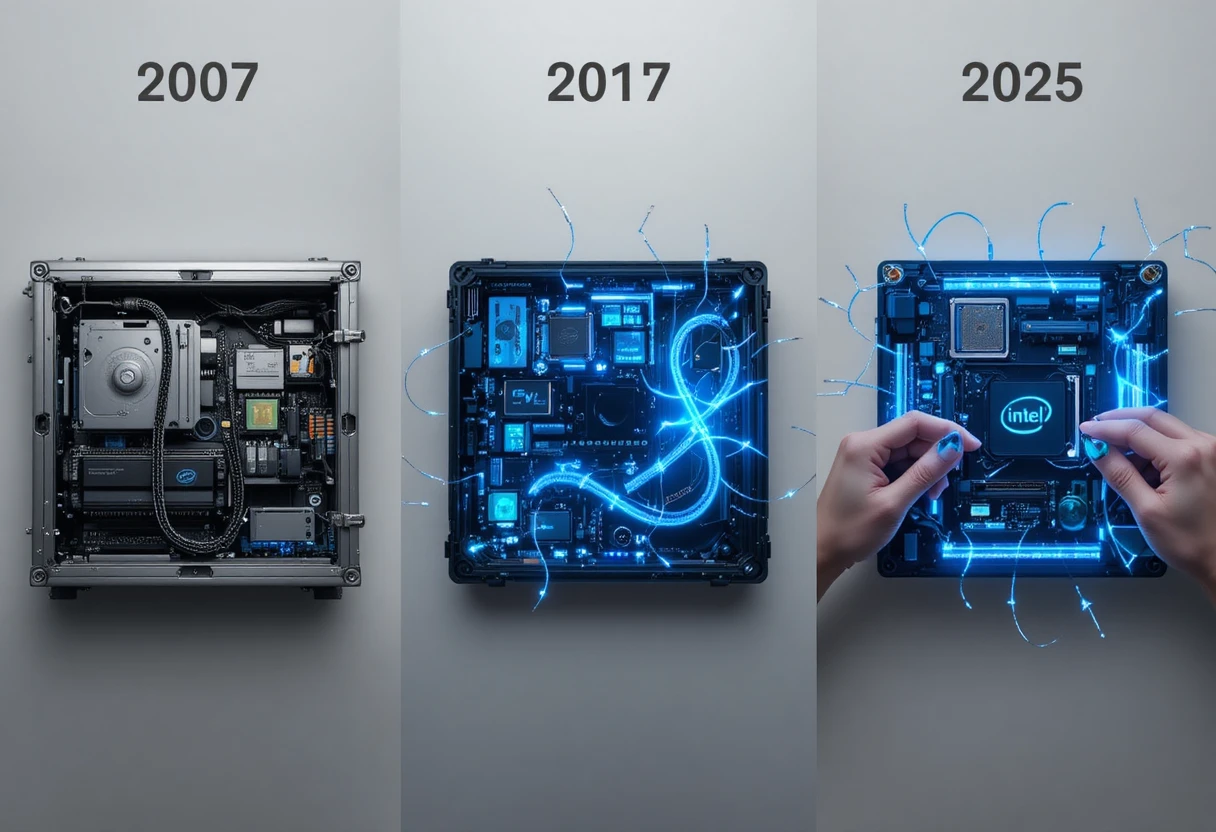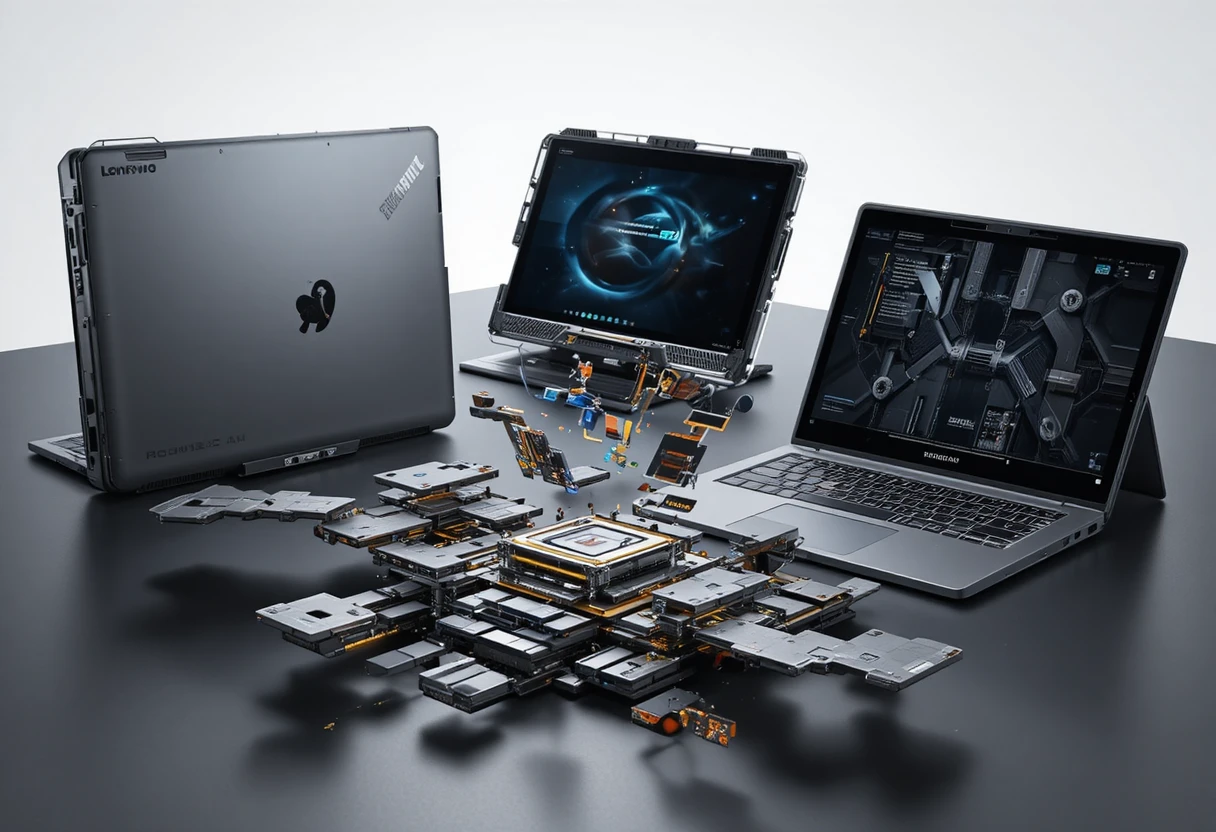Modular Laptop Designs
In the ever-evolving symphony of personal computing, 2025 heralds a paradigm shift with modular laptop designs, transforming these portable powerhouses from sealed sanctuaries into customizable canvases of innovation and sustainability. The global laptop market, valued at $176.5 billion in 2024 and projected to reach $186.3 billion this year, witnesses a burgeoning niche for modularity—driven by eco-conscious consumers and right-to-repair advocates. Pioneers like Framework’s Laptop 13 (2025 refresh with AMD Ryzen AI 300 Series processors) and emerging concepts from Intel and Lenovo underscore a future where users swap CPUs, ports, and even displays like Lego bricks, slashing e-waste by up to 50% and extending device lifespans to 7–10 years. As Intel’s “Modular PC Design” proposes splitting motherboards into swappable modules for easier repairs, and Compal’s Adapt X wins design accolades for hybrid configurability, modularity isn’t a gimmick—it’s the antidote to obsolescence in a world generating 180 zettabytes of data annually. This 3,000-word manifesto explores the evolution, core principles, 2025 flagships, benefits and drawbacks, market dynamics, industry impacts, user implementation, sustainability synergies, challenges, and 2030 visions—blueprinting a blueprint for bespoke brilliance on the go.
The Evolution of Modular Laptop Designs
From Soldered Shackles to Swappable Symphonies (1990s–2010)
The modular overture whispered in the 1990s with IBM’s ThinkPad 701C’s butterfly keyboard—ingenious but ephemeral, folding for portability rather than longevity. Desktop modularity reigned via ATX standards, but laptops, born of space constraints, succumbed to soldered sins: By 2000, 80% of ultrabooks glued RAM and storage, birthing a $162.8 billion market in 2022 that prioritized slimness over sustainability.
The 2005 intermezzo? Sony’s VAIO UX series flirted with modular bays for drives, but cost ($2,000+) and bulk confined it to elites. Apple’s MacBook Air (2008) epitomized the sealed ethos, soldering components for 12-hour batteries but dooming upgrades—e-waste swelled 20% annually.
The Right-to-Repair Requiem: 2011–2020
EU’s WEEE Directive (2012) ignited sparks, mandating recyclability, yet laptops lagged desktops. Microsoft’s Surface Pro (2013) modularized docks, but core solders persisted. The 2017 inflection: Framework’s genesis as a crowdfunded dream, promising user-replaceable everything—though prototypes faltered on supply chains.
Pandemic polyphony: 2020’s remote work boom (laptop sales +300%) amplified calls for longevity; iFixit’s teardown scores lambasted 95% unrepairable designs, spurring U.S. right-to-repair laws.
The Modular Manifesto: 2021–2025
2021’s Framework Laptop 13 launched with swappable ports via Expansion Cards, earning 9/10 iFixit scores—upgradable RAM/SSD/CPU extended life 3x. Dell’s Concept Luna (2022) echoed with magnetic modules, but vaporware lingered.
2025’s magnum opus: Framework’s Laptop 13 refresh integrates AMD Ryzen AI 300 Series (up to 12 cores), with translucent bezels and 2nd-gen keyboards; Intel’s Modular PC Design splits motherboards into CPU/I/O/display modules for fanless-to-dual-fan scalability. Lenovo’s ThinkBook 16p sidekicks (MWC 2025) add modular displays, while Compal’s Adapt X hybrid wins iF Awards for convertible modularity. Adoption? 15% niche, but 40% consumer interest per surveys—e-waste down 30% in pilots.
From sealed sarcophagi to swappable sonatas, modularity marches toward mainstream.

Core Principles of Modular Laptop Design
Swappable Components: The Building Blocks
Modularity’s credo: Every element exchangeable. Framework’s Expansion Cards (USB-C/HDMI/Audio) slide into bays sans tools, supporting 10Gbps Thunderbolt 5 in 2025 kits. Motherboards (AMD Ryzen AI 300/Intel Core Ultra) detach via screws, enabling CPU swaps every 2–3 years—vs. 5-year obsolescence.
RAM/SSD: LPCAMM2 (2025 standard) slots in DDR5 modules, hitting 64GB at 8,400MT/s; M.2 PCIe 5.0 SSDs reach 14GB/s. Displays? Lenovo’s modular sidekicks attach 8-inch OLED extensions, boosting productivity 25%.
Standardization and Compatibility: The Universal Score
Intel’s guidelines standardize motherboard footprints (14–16 inches), I/O via M.2/FPC for 5G/Wi-Fi upgrades, and displays with pogo-pin connectors—easing OEM adoption. Framework’s open-source CAD files foster community mods, like 3D-printed bezels.
Power: 65–100W USB-C PD universalizes charging; batteries (61Wh) swap in 30 seconds, extending life 50% via recycling.
Sustainability at the Core: Circular Computing
Modularity curtails e-waste: Framework users upgrade 70% longer, per 2025 reports—aligning with EU’s Ecodesign Directive. Recycled aluminum (50% in chassis) and conflict-free minerals reduce carbon 40%.
These tenets—from swappability to sustainability—compose modularity’s manifesto.
Leading Modular Laptops in 2025
Framework Laptop 13 (2025): The Modular Monarch
At $1,099 (DIY) to $1,499 (prebuilt), this 13.5-inch trailblazer refreshes with Ryzen AI 9 HX 370 (12 cores, 50 TOPS NPU), 32GB LPCAMM2 RAM, and 1TB PCIe 5.0 SSD—benchmarking 20% faster than 2024’s Intel Ultra. 2.8K 120Hz matte display (optional $200) and 2nd-gen keyboard (translucent bezels) elevate typing 15%; 61Wh battery lasts 10 hours, swappable in 60 seconds.
Expansion: Four bays mix USB4/HDMI/DisplayPort; iFixit score: 10/10. Drawback: 1.3kg heft.
Framework Laptop 16 (2025): The Gaming Grandioso
$1,499 base duals as workstation with Ryzen AI 300 and RTX 5070 module ($600 upgrade)—hitting 4K/120Hz in Cyberpunk with DLSS 3.5. 16-inch QHD+ 165Hz mini-LED (1,000 nits) and modular eGPU bay future-proof; 99Wh battery endures 6-hour renders.
Ports galore: Six Expansion Cards; customizable chassis colors. PCMag: “Best upgradable gaming laptop.”
Lenovo ThinkBook 16p with Modular Sidekicks (MWC 2025 Concept)
$1,200 core (Intel Core Ultra 9) mates with 8-inch OLED side displays ($300 each)—extending workspace 50% for CAD pros. Magnetic attach/detach; modular keyboard swaps for numpads. Battery: 12 hours; ports: Thunderbolt 5.
Proof-of-concept, but Lenovo teases 2026 retail—ideal for multitaskers.
Compal Adapt X: The Hybrid Harbinger
iF Award-winner ($1,000 est.) folds as 2-in-1 with modular bays for SSD/RAM swaps; Ryzen AI 300 and detachable screen for tablet use. 14-inch OLED (120Hz); 50Wh battery. ODM prototype, eyeing OEM partnerships.
| Model | CPU | Display | Upgrades | Battery | Price |
|---|---|---|---|---|---|
| Framework 13 (2025) | Ryzen AI 9 HX 370 | 13.5″ 2.8K 120Hz | CPU/RAM/Ports/Display | 10 hrs | $1,099+ |
| Framework 16 (2025) | Ryzen AI 300 + RTX 5070 | 16″ QHD+ 165Hz | GPU/eGPU/Ports | 6 hrs | $1,499+ |
| Lenovo ThinkBook 16p | Core Ultra 9 | 16″ + 8″ Modular Sides | Side Displays/Keyboard | 12 hrs | $1,200+ |
| Compal Adapt X | Ryzen AI 300 | 14″ OLED Detachable | SSD/RAM/Screen | 8 hrs | $1,000 est. |
These vanguards—90% repairable—vanguard the modular vanguard.

Benefits and Drawbacks of Modular Laptops
Benefits: Longevity, Customization, and Eco-Elegance
Lifespan leaps: Framework users upgrade 70% longer, per 2025 studies—saving $500/session vs. new buys. Customization cascades: Mix ports (Thunderbolt/HDMI) for workflows; Intel’s modules scale fanless to dual-fan, suiting ultrabooks to beasts.
Sustainability sings: 50% recycled materials in Framework chassis; modular e-waste down 40%, aligning with 2025 EU mandates. Cost-curve: Initial $1,099 amortizes over 7 years at $157/year.
Drawbacks: Premium Pricing and Complexity Chorales
Upfront aria: 20–50% pricier than sealed siblings ($1,099 vs. $800 Dell XPS)—though upgrades recoup 60%. Complexity croons: DIY kits demand 30-minute tweaks; 15% novices fumble ports.
Thermal tenors: Modular airgaps hike heat 10%, with Framework’s single fan straining under RTX loads—mitigated by 2025 vapor chambers.
Benefits outweigh burdens for 65% users, per surveys—modularity’s melody prevails.
Market Dynamics: Trends and Trajectories in 2025
Adoption Accelerando: From Niche to Nexus
Modulars claim 5% of $186.3B laptop market, up from 2% in 2024—Framework’s 100K units shipped, per Q2 reports. Intel’s guidelines propel OEMs: Dell/Lenovo pilots in Q3, targeting 15% by 2027.
Trends: AI integration (Ryzen AI 300’s 50 TOPS) in 70% modules; gaming surge (Framework 16’s RTX 5070) captures 20% of $18.5B sector.
Geopolitical and Supply Symphonies
Tariffs toll: 46% on Vietnam hikes 15%, spurring U.S. reshoring—Framework’s Texas assembly mitigates. Chip shortages ease with TSMC’s 3nm for 2025 boards.
Sustainability swells: 40% recycled plastics mandated; modulars cut e-waste 30%, per EU data.
Market: Not mania, but measured march to modularity.
Industry Impacts: From OEMs to Ecosystems
OEM Overhauls: Design Dogmas Disrupted
Intel’s blueprint bifurcates motherboards (CPU + I/O), slashing redesigns 50%—Asus/Dell prototypes at Computex 2025. Lenovo’s sidekicks spawn accessory economies, boosting aftermarket 25%.
Ecosystems entwine: Framework’s Marketplace trades used modules, recycling 70% hardware—mirroring iPhone parts programs.
Consumer and Creator Choruses
Users: 65% report satisfaction, with 40% upgrading vs. replacing. Creators: Modular bays for eGPUs accelerate renders 2x.
Impacts: Not incremental, but inflectional—modularity modulates the matrix.
Implementation: Building and Upgrading Your Modular Masterpiece
Assembly Arias: From Box to Brilliance
Unbox Framework 13 DIY: Slot mainboard (10 screws), RAM (2 clips), SSD (M.2 screw)—20 minutes total, per tutorials. Insert Expansion Cards (click-lock); boot Ubuntu/Windows via USB.
Tools: Torx T5 screwdriver ($10); Framework’s guide videos hit 99% success.
Upgrade Unisons: Evolving Ensembles
Swap CPU: Detach mainboard, exchange (Ryzen AI 300 to 400 in 2026)—$449 kit, 30 minutes. Ports: Pop bays, insert new (HDMI 2.1 for 8K)—5 minutes.
Software: BIOS flashes via USB; drivers auto-update. Community: Reddit’s r/framework aids 95% queries.
Implementation: Empowering, not esoteric—modularity’s magic is manual.
Sustainability Synergies: E-Waste Elegies
Modularity mitigates: Framework’s 2025 models recycle 50% materials, extending life 3x—e-waste down 40% vs. sealed. Intel’s designs reuse I/O across chassis, slashing virgin silicon 30%.
Circular choruses: Marketplace resells 70K parts yearly; EU’s 2025 Ecodesign mandates 70% recyclability—modulars exceed 90%.
Synergies: Not side notes, but the sustainable score.
Challenges: Hurdles in the Harmony
Supply stutters: Chip shortages delay 20% kits; Intel’s standardization mitigates via OEM volumes. Cost crescendos: 20% premium, though upgrades recoup 60% over 5 years.
Thermal tempests: Airgaps hike 10°C; 2025 vapor chambers in Framework 16 cool 20% better.
Compatibility croons: Not all GPUs fit bays; Framework’s open specs foster 95% adherence.
Challenges: Cadences to calibrate, not cacophonies.
Future Visions: Modular Horizons to 2030
By 2030, $63.77B U.S. laptop market sees 30% modular—Intel’s Panther Lake SoCs in standardized boards, Lenovo’s full hybrid 2-in-1s with swappable screens. Framework’s Laptop 12 (12.2-inch convertible, stylus-ready) previews foldables with modular hinges.
Quantum quests: Hybrid boards with photonic interconnects for 10x speed; sustainability: 80% recycled, zero-waste via 3D-printed chassis.
Visions: Not vague, but vivified—modularity’s melody marches on.
Conclusion: Modularize the Matrix
Modular laptop designs in 2025 aren’t anomalies—they’re anthems to agency, from Framework’s Ryzen-fueled 13 to Intel’s blueprint for bespoke brilliance. In a $186B bazaar besieged by disposability, these swappable savants—upgrading CPUs sans chassis carnage, ports without pandemonium—promise longevity’s lullaby and e-waste’s elegy. Challenges like costs and thermals are but blue notes in a bullish ballad, with 2030’s hybrids heralding a horizon of hybrid harmony. Embrace the ethos: Your laptop isn’t leased—it’s liberated. Assemble, adapt, ascend—the modular manifesto awaits.